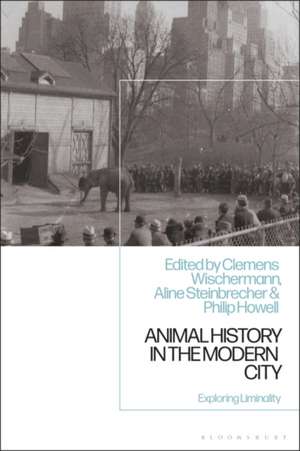Animal History in the Modern City: Exploring Liminality
Editat de Prof. Clemens Wischermann, Dr. Aline Steinbrecher, Dr. Philip Howellen Limba Engleză Paperback – 18 mar 2020
| Toate formatele și edițiile | Preț | Express |
|---|---|---|
| Paperback (1) | 224.66 lei 6-8 săpt. | |
| Bloomsbury Publishing – 18 mar 2020 | 224.66 lei 6-8 săpt. | |
| Hardback (1) | 715.66 lei 6-8 săpt. | |
| Bloomsbury Publishing – 5 sep 2018 | 715.66 lei 6-8 săpt. |
Preț: 224.66 lei
Preț vechi: 288.82 lei
-22% Nou
Puncte Express: 337
Preț estimativ în valută:
42.100€ • 44.77$ • 36.34£
42.100€ • 44.77$ • 36.34£
Carte tipărită la comandă
Livrare economică 10-24 martie
Preluare comenzi: 021 569.72.76
Specificații
ISBN-13: 9781350155237
ISBN-10: 1350155233
Pagini: 264
Ilustrații: 25 bw illus
Dimensiuni: 156 x 234 mm
Greutate: 0.37 kg
Editura: Bloomsbury Publishing
Colecția Bloomsbury Academic
Locul publicării:London, United Kingdom
ISBN-10: 1350155233
Pagini: 264
Ilustrații: 25 bw illus
Dimensiuni: 156 x 234 mm
Greutate: 0.37 kg
Editura: Bloomsbury Publishing
Colecția Bloomsbury Academic
Locul publicării:London, United Kingdom
Caracteristici
Features case studies with wide geographical coverage, including European countries and some of its colonies, thus avoiding the common dominance of the British/American perspective
Notă biografică
Clemens Wischermann is Chair of Economic and Social History at the University of Constance, Germany. He has published widely on the history of industrialization and urbanization in 19th- and 20th-century Europe. He is the author of Advertising and the European City: Historical Perspectives (2000).Aline Steinbrecher is Fellow at the University of Constance, Germany. She is a cultural and social historian of the early modern period and one of the leading German authors in the field of animal history.Philip Howell is Reader at the University of Cambridge, UK. He is the author of At Home and Astray: The Domestic Dog in Victorian Britain (2015) and Geographies of Regulation: Policing Prostitution in Nineteenth-Century Britain and the Empire (2009).
Cuprins
List of Illustrations1. Liminality: A Governing Category in Animate History Clemens Wischermann (University of Konstanz, Germany) and Philip Howell (University of Cambridge, UK)2. Liminal Lives in the New World Isabelle Schurch (University of Konstanz, Germany)3. Liminal Moments: Royal Hunts and Animal Lives in and Around Seventeenth-Century Paris Nadir Weber (University of Bern, Switzerland)4. Antisocial Animals in the British Atlantic World: Liminality and Nuisance in Glasgow and New York City, 1660-1760 Andrew Wells (University of Göttingen, Germany) 5. Canaries and Pigeons on the Threshold: An Eighteenth-Century Case Study of Liminal Animal Lives in a Southwest German Hometown Dennis A. Frey Jr (Lassell College, USA) 6. The Giraffe's Journey in France (1826-7): Entering Another World Eric Baratay (Jean Moulin University Lyon 3, France) 7. The Elimination of the German Butcher Dog and the Rise of the Modern Slaughterhouse Annette Leiderer (Albert Ludwig University of Freiburg, Germany)8. It's Just an Act! Dogs as Actors in Eighteenth- and Early Nineteenth-Century Europe Aline Steinbrecher (University of Konstanz, Germany)9. Between Wild and Domestic, Animal and Human, Life and Death: The Problem of the Stray in the Victorian City Philip Howell (University of Cambridge, UK)10. Liminal Youth between Town and Bush: Humans, Leopards and Initiation in West African History Stephanie Zehnle (University of Kassel, Germany) 11. Betwixt and Between: Making Makeshift Animals in Nineteenth-Century Zoological Gardens Wiebke Reinert (University of Kassel, Germany) 12. Liminality in the Post-War Zoo: Animals in East and West Berlin,1955-61 Mieke Roscher (University of Kassel, Germany) 13. Backyard Birds and Human-Made Bat Houses: Domiciles of the Wild in Nineteenth- and Twentieth-Century Cities Dolly Jørgensen (University of Stavanger, Norway) Index
Recenzii
A smart, innovative, and inspiring intervention into the increasingly-crucial field of Human-Animal Studies from an impressive group of researchers. Readers will find many fascinating stories that expose the grey areas between imagined categories (e.g. feral, wild, pest) that people have used (often unsuccessfully) to constrain animals.
This innovative volume expertly places animal studies in conversation with urban history and the interdisciplinary concept of liminality. Blending theory and empirical case studies in surprising and fascinating ways, the volume maps out new directions in animal and urban studies.
This innovative volume expertly places animal studies in conversation with urban history and the interdisciplinary concept of liminality. Blending theory and empirical case studies in surprising and fascinating ways, the volume maps out new directions in animal and urban studies.
